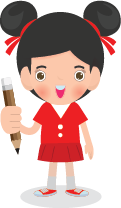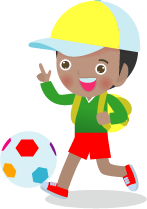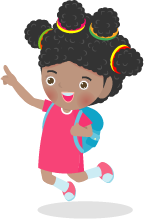Kindergarten Readiness Checklist
Not sure if your child is ready to tackle the world of kindergarten? Our Kindergarten Readiness Checklist will give you an idea on what areas your child is doing well in, and where they may need some extra attention. It’s a good idea to do the checklist, print it out and then work with your child in the areas they need extra help. In a few weeks, do the checklist again to see how much your child has improved.

-
Eats independently
- Uses restroom, including hand washing
-
Puts on and removes outerwear (e.g. zips, buttons, ties)
-
Asks questions and seeks help when needed
- Cleans up after self
Things You Can Do
- Patiently encourage your child to do things independently, even if it takes more time.

-
Holds pencils, crayons, scissors, etc. correctly
- Writes his/her first name
-
Uses scissors to cut straight and curved lines
-
Turns a single page in a book
Things You Can Do
- Provide opportunities and support for your child to practice writing, drawing, and cutting. Help them practice lacing items, such as shoes. Have your child pour, stir, and participate in other functional activities around the home.

-
Performs activities that cross the mid line of the body (e.g. right hand touching left foot, left elbow touching right knee)
-
Hops, jumps, walks, and runs
-
Bounces, catches, kicks, and throws balls
-
Walks in a straight line forward and backward
-
Balances on dominant foot for ten seconds
Things You Can Do
-
Provide opportunities to develop strength and coordination. Get outside and play games with your child.

-
Counts out loud to ten correctly
-
Begins to count to 20
-
Counts objects by touching one object at a time
-
Recognizes and creates groups of 2, 3, 4, or 5 objects
-
Sorts similar items (e.g. blue toys and red toys)
-
Identifies, names, and draws shapes (e.g. circle, triangle, square, and rectangle)
-
Uses comparative words (e.g. more/less, bigger/smaller, longer/shorter, heavier/lighter)
Things You Can Do
-
Play games in which your child counts out loud (e.g. hide and seek). Encourage your child to count objects in the environment (e.g. pieces of cereal, people in their family). Point out shapes in the environment (e.g., shapes on a sign).

-
Tries new things
-
Shares and takes turns
-
Waits and listens while others talk
-
Shows concern for others
-
Plays cooperatively with others
-
Works well independently and in small groups
-
Separates from parent or guardian without undue anxiety
- Reasonably manages his/her emotions
-
Knows his/her first and last name and can tell an adult
- Knows parent’s or guardian’s first and last names and can tell an adult
Things You Can Do
-
Provide opportunities for exploration, play, and socialization with other children and adults. These experiences allow your child to practice their social skills. Sharing objects or time with an adult is different from doing so with another child. Children develop their imaginations by role- playing and pretending.

-
Listens attentively and responds to stories and books
-
Speaks in complete sentences
-
Speaks clearly enough to be understood by others
-
Identifies rhyming words in stories, poems, and songs
-
Knows that letters of the alphabet have specific sounds
-
Identifies the first sound he/ she hears in random words
-
Identifies signs, symbols, or logos in the environment
-
Identifies some uppercase and lowercase letters, including those in his/her name
-
Uses beginning writing skills (e.g. drawing, scribbling, writing) to express ideas
Things You Can Do
-
Have conversations with your child, including taking turns asking questions back and forth. During conversations ask your child to describe things they see, hear, smell, taste, and/or feel. Children learn language when they hear it and use it. Use signs in the environment as natural learning opportunities (e.g. That sign says “stop!” The first letter is s, it makes the “sss” sound: “ssstop”). Read a variety of books with your child.
-
Your child must be five years old BEFORE September 2 of the enrolling year.
-
You may be asked to provide:
-
An official birth certificate.
-
An immunization record or exemption form.
-
Proof of your current address (utility bill, driver’s license, etc.).
-
-
Check with your local school district or charter school for additional requirements.
Helpful Resources
- If you are concerned about your child’s development from birth through school age, contact your local school district. For additional resources and information visit: USBE Special Education Services.
- For more information regarding licensed child care, visit: Workforce Services Child Care.
- Head Start serves the child development needs of low- income children (birth through age five) and their families.
Source: USBE “Kindergarten Here We Come” pamphlet


 UTAH EDUCATION NETWORK
UTAH EDUCATION NETWORK

 Justin
Justin Braxton
Braxton Dani
Dani Rob
Rob Val
Val
